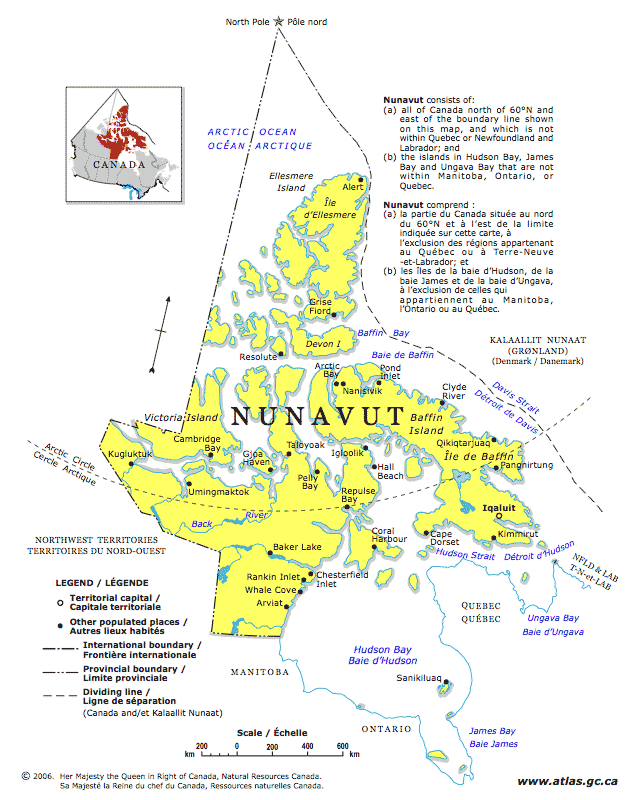
Courtesy of Canada.gc.ca
BAKER LAKE
Baker Lake (or Qamani’tuuq in Inuktitut, meaning “where the river widens”) is Nunavut’s only inland community. Located close to the geographic center of Canada, Baker Lake is situated at the mouth of the Thelon River in the Kivalliq region. It is a prominent arts and crafts community today. Artists and studios such as the Inuit Heritage Centre, the Jessie Oonark Centre, and well-established independent galleries are assets to the community’s arts and crafts industry, which developed in the late 1960s when many artists settled in the area. Baker Lake sculptors prefer large carvings of hunters and animals t hat often emphasize the relationship between animal and human, and are made of hard Keewatin stone. The sculptures, while realistic in depiction, are not as detailed as sculptures from other regions such as Cape Dorset and rather tend to be more abstract and simplified, without much polishing. See work from Baker Lake by clicking here.
CAPE DORSET
Cape Dorset is a hamlet located on Dorset Island at the southern tip of Baffin Island, in the Qikiqtaaluk Region of Nunavut, Canada. The Inukitut name for Cape Dorset, Kinngait, means “high mountains” and refers to the picturesque hills that surround the community. An abundance of artists live and work in Kinngait. It is the most well-known art producing community in Canada’s arctic, which can be fairly attributed to the establishment of the West Baffin Eskimo Co-operative in 1959. The Co-op has earned an international reputation for its printmaking studio and its Inuit artist-members who work there, who produce stonecut prints, etchings, and lithographs in addition to carvings. The annual Cape Dorset Print Collection, launched in October of each year, is a highly anticipated event for art lovers. Many make the trip from the south and abroad to Cape Dorset each year to enjoy the treasures of the West Baffin Eskimo Co-operative and speak with the acclaimed artists who work there. Recently in 2011 Canadian artist Shary Boyle (who was selected to represent Canada at the 2013 Venice Biennale) completed an artist residence at Cape Dorset and arranged a collaboration with graphic artist Shuvinai Ashoona at the Co-op.
Cape Dorset carvers are predominantly known from their naturalistic representations of animals and legends. The artists of this region favour a dark black or green serpentine, which they carve with great detail and elegance. While the sculptures are slightly stylized, the presence and spirit of the animals are intrinsic within the works. The inherent strength of the serpentine enables the sculptures to be highly polished and made in a massive scale. See all work produced in Cape Dorset by clicking here.
GJOA HAVEN
Gjoa Haven is a hamlet in Nunavut located above the Arctic Circle in the Kitikmeot region of Nunavut. Its Inuktitut name, Usqsuqtuuq, means “a place of plenty of fat” and refers to the great quantity of sea mammals surrounding the hamlet. Traditionally and formerly influenced by the style of artists from nearby Taloyoak, contemporary carvers of Gjoa Haven have since developed a distinct and influential style of their own. This shift can be partly attributed to the Puqiqnak family of carvers who developed a grotesque style to their carvings of human figures, most frequently hunters, dancers and shamans with contorted bodies and expressive faces and gaping mouths with inlaid bone for teeth. Wayne Puqiqnak, son of acclaimed artist Uriash Puqiqnak, is the third generation of his family to continue this iconic grotesque style that has come to characterize the region. Uraish is also an active politician, formerly the mayor of Gjoa Haven and was appointed to the Order of Canada in 2005.
IQALUIT
Iqaluit, formerly Frobisher Bay, is located on the south coast of Baffin Island. It is the central hub to the north and south in the Baffin region and was formerly the administrative centre of the former Northwest Territories. It was selected as the capital of Nunavut in December 1995. It is Canada’s fastest growing community and home to many talented artists and as such, there is not one homogenous or distinctive style to the community like other Inuit art making communities. However, like Cape Dorset, carvings of animals are often naturalistic and highly polished, but are often either in exaggerated, unusual or heroic poses.
PANGNIRTUNG
The Inuit hamlet of Pangnirtung (or Pang, Pangniqtuuq) is located on Baffin Island in the Qikiqtaaluk Region of the Canadian territory of Nunavut. The Uqqurmiut Centre for Arts & Crafts is a major artistic center, which opened in 1991. The Centre serves the entire art and craft community of the village with facilities and equipment for the Pangnirtung Print Shop, Tapestry Studio, retail Craft Gallery and administrative spaces.
SANIKILUAQ
Located on the Belcher Islands of Hudson Bay, Sanikiluaq is the southernmost community of Nunavut. It is approximately 150 kilometres off the west coast of Quebec in the Hudson Bay. The Arctic wildlife of this region is a popular subject of carvers, particularly birds and marine mammals. Sanikiluaq carvings are generally naturalistic in style and are frequently polished with very minute detail. Argillite is the native stone of Sanikiluaq, an opaque stone that varies in colour from black to dark grey, and has distinctive striped grain.
TALOYOAK
Formerly Spence Bay, Taloyoak is located on the Boothia Peninsula in the Kitikmeot region of Nunavut, and is the northernmost community on the Canadian mainland. This community first became popular for its large whalebone sculptures. The most influential Taloyoak artist was Karoo Ashevak, whose style has been appropriated by some artists who still carve whalebone. Stone is arguably the main carving material today, although artists still carve bone and ivory. Taloyoak is well-known for the famous Spence Bay Packing Dolls that have been produced since the early 1970s in the region.

